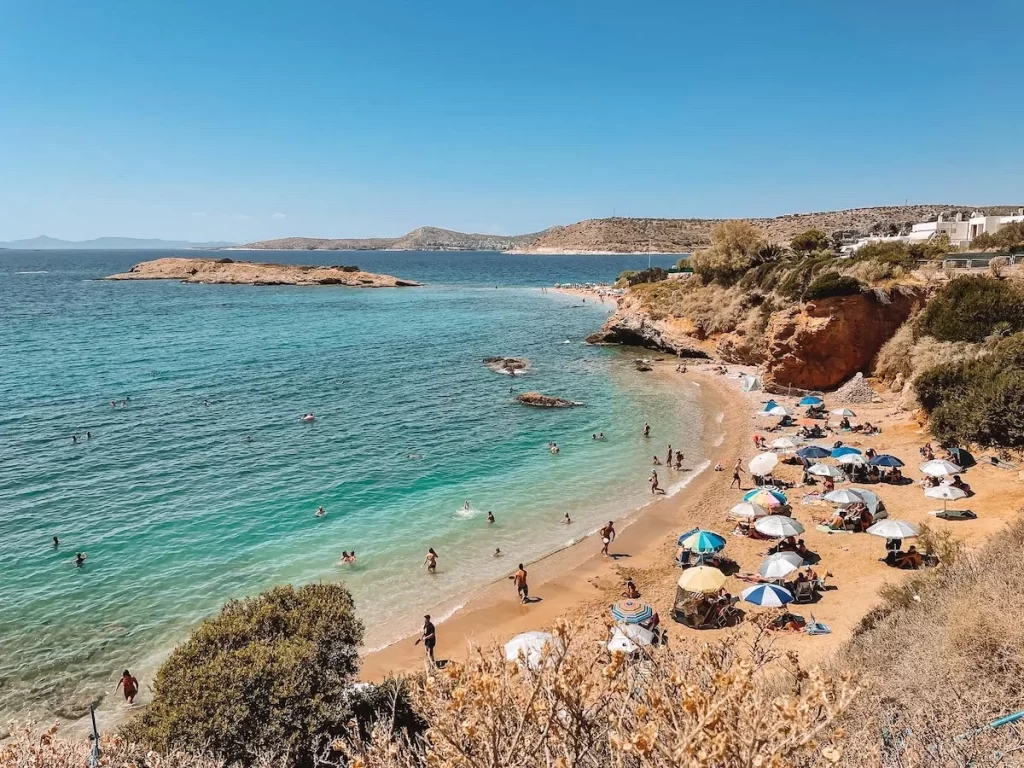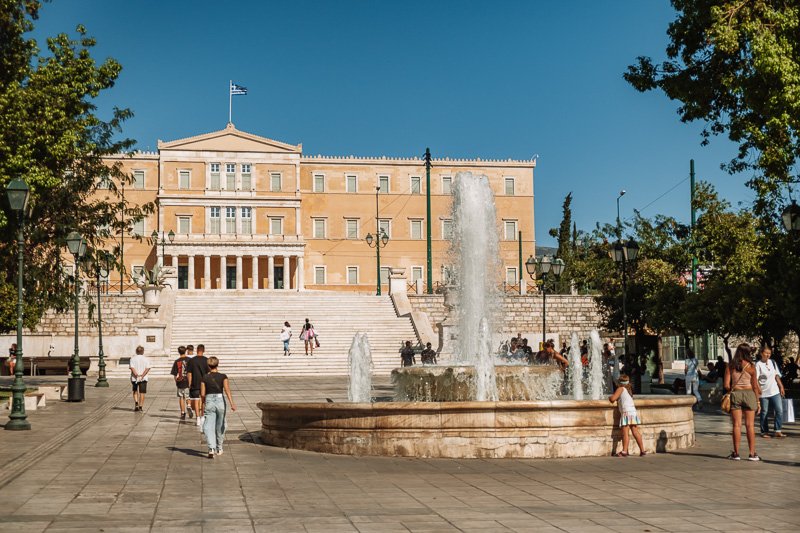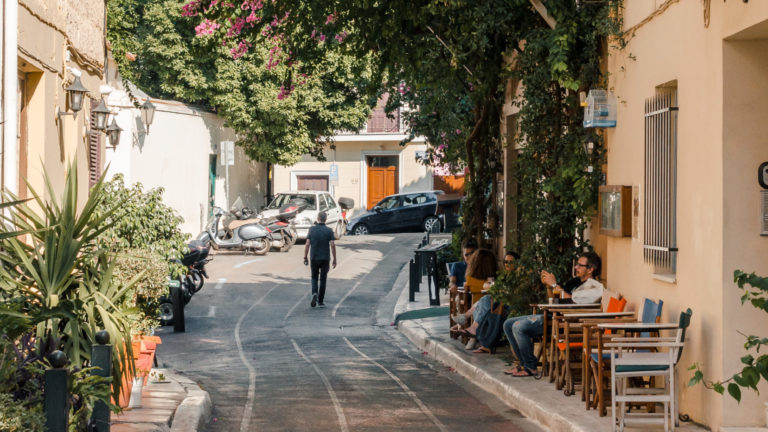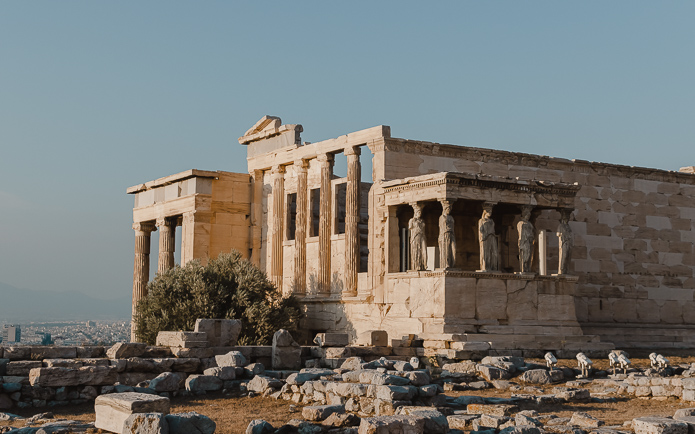
Athens is one of Europe’s oldest cities (if not the oldest) and you can see how by wandering around the city centre’s historical monuments. Even after two years spent living here, visiting these beautiful ancient sites never gets old! Based on my experience, here is a local’s guide to Athens historical monuments and sites, full of practical information so you can make the most out of your stay in Athens.
This article contains affiliate links, which allows me to earn a small commission on any purchase you make through my links, at no extra cost to you. It helps me keep this blog running, thanks for understanding!
Practical information about Athens’ historical monuments and sites
Before visiting Athens historical monuments, make sure you are well equipped, especially during the hot summer months. This means wearing good shoes (the sites are clearly not flat and the marble is at some spots really slippery), a hat, and carrying some water with you. Not all archaeological sites have freshwater sources available so keep it in mind.
The best times to visit the historical monuments during summer are early mornings and late afternoons when the heat isn’t at its peak and tourists are few. If you want to (almost) completely avoid the crowds, think about visiting Athens during the low season (November – March). A really nice time to visit Athens is in October, while tourists are fewer and the weather is still warm – this year we enjoyed temperatures going up to 25°C till the beginning of November!
Sites’ closing hours change all around the year, following the time at which the sun sets. Before your visit make sure to check opening hours on the Ministry of Culture’s website.
There is a combined ticket of 30€ which includes admissions to several historical monuments in the center of Athens. I highly recommend you buy this ticket if you plan on visiting several sites! It includes entrances to the Acropolis, Ancient Agora, Roman Agora, Hadrian’s Library, Olympieion, Kerameikos, Aristotle’s School and can be used 5 days after the first entrance. There is free admission to most historical monuments (including the Acropolis) for students, EU members under 25 years old, and other cases. You can find more information on that on the Ministry of Culture’s website as well. Finally, you can buy your tickets online or directly at each historical landmark of Athens.
Now let’s dive into Athens’ impressive historical monuments and sites!

The 7 best historical sites in Athens, Greece
The Acropolis and its surroundings
The Acropolis is the central point of Athens. The first citadel of Athens was built there, about 5000 years B.C., on a rocky hill for defence reasons: they could easily see the enemy coming from their high point. “Acropolis” actually means “high city” and this kind of citadel, built on a hill, can be found in many ancient Greek towns!
How to access the Acropolis
You can access the Acropolis hill by two different entrances. One is located opposite the Acropolis Museum in the pedestrian street of Dionysiou Areopagitou, next to the metro station Acropolis. There are usually fewer people waiting to go in at this entrance as the buses leave most tourists at the other entrance, so I usually use this one.
However, the other entrance which you will find on the west side of the Acropolis, on the way to the Areopagus hill, is closer to the Acropolis and better suited if:
a) You visit the Acropolis at opening hours and want to avoid the crowds: this entrance is closer to the top of the hill so go straight at the top and stop by the other theatres afterwards.
b) You are visiting with small children or have a stroller/wheelchair. This entrance will allow you to take it with you higher up than the other one. You can contact the site’s administration beforehand if you want to use the elevator that can take you all the way up (you can find contact information on the Ministry of Culture’s website). If you want to leave a stroller/wheelchair, ask for more information at the entrance. They have a place where you can leave it and pick it up after your visit.
Opening hours
During summertime, the Acropolis is open between 8:00 and 20:00. Closing hour changes during the year according to sunset time, you can check the exact closing hour before your visit on the Ministry of Culture’s website which is frequently updated. During the low season (from November 5th), the site is open between 8:00 and 17:00.
Tickets
Full-priced tickets cost 20€, reduced ones 10€. The entrance is included in the combined ticket. You can buy your tickets online or directly on the site.
The information you will find around the site is very limited, so don’t expect to learn all about the history of the place once there. I would recommend following the explanations of a guide, and/or visit the Acropolis Museum. I personally think it’s better to visit the museum before the Acropolis, so once up there you can visualize everything you’ve learned at the museum.
What to see at the Acropolis
The area you can visit actually starts at the bottom of the Acropolis. If you come in at the opening, climb straight to the Acropolis to enjoy the place before it gets really crowded. Before you fully climb the stairs, you can admire on the right the temple of Athena Nike with its beautiful columns of Ionian style. A statue of Athena Nike, the “winged” victory, originally stood at the center of the temple and was worshipped by Athenians. According to the legend, Athenians deprived the statue of her wings so the victory could never leave Athens. Smart, huh?
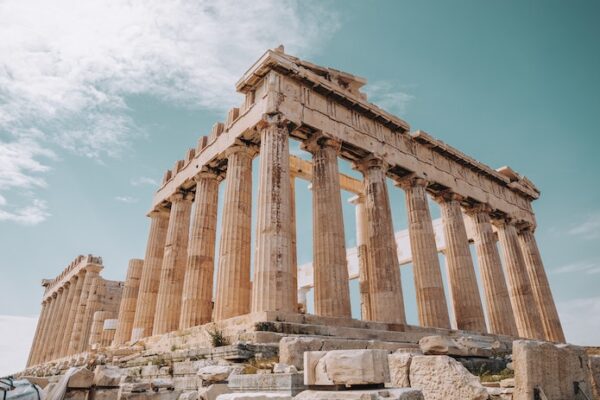
At the top of the stairs, cross the impressive Propylaea, the monumental gates of the Acropolis. Right after that, head to the Parthenon. Imagine that inside this impressive temple there used to be an even more impressive chryselephantine statue of the goddess Athena, only made of ivory and gold and reaching 12 meters high. They had good taste! On the left of the Parthenon are the Erechteion and its famous Porch of the Caryatids, known for its columns being statues of beautifully draped young women.

The other thing to enjoy when being at the top of the Acropolis is the view over Athens. Go up to where the Greek flag is to enjoy a view over the center. You will be able to spot other famous monuments such as the Temple of Olympian Zeus, the Panathenaic Stadium and Mount Lycabettus.
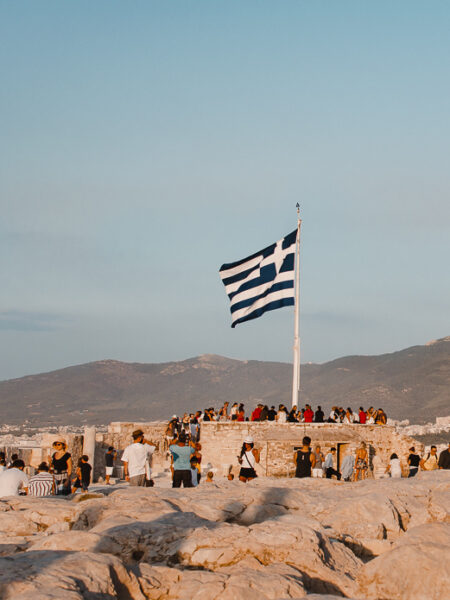
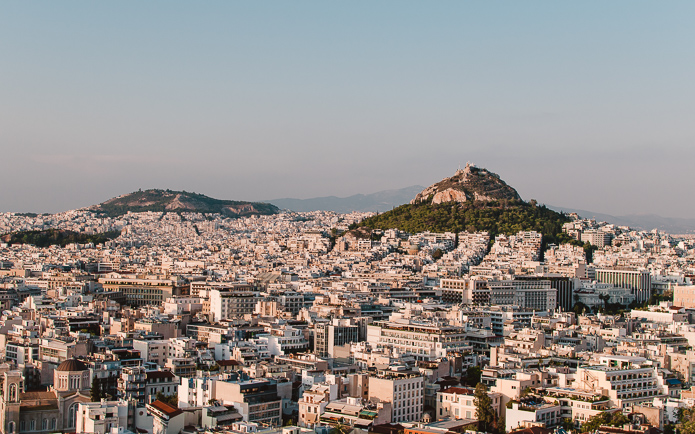
From the other side of the Acropolis, you will be able to see the sea and till the port of Piraeus. On the way down, don’t forget to make a stop at the Odeon of Herodes Atticus, a stunning open-air theatre that is still frequently used for performances today. The theatre of Dionysos is also a must-see (though it isn’t in such good condition as the Odeon of Herodes Atticus is) and is considered to be the world’s first theatre.

The Acropolis Museum
To complete your visit to the Acropolis it is a good idea to visit the Acropolis Museum where you will learn all about the history of the place and see beautiful antic statues and sculptures. It is absolutely fantastic in my opinion!
The top floor of the museum has been built as a replica of the Parthenon (same surface area and orientation). There you can admire the pieces of the Parthenon frieze. The museum also has a great restaurant from which you can enjoy the view on the (real!) Parthenon.
The entrance is not included in the combined ticket (10€ full price during high season) and the opening hours are different every day so make sure you check before going there.
The Philopappos Monument
Philopappos was a Roman senator of Greek origin who spent most of his life in Athens after his family was forced into exile. Considered as a benefactor to the city, his sister erected the monument to honor his memory in 118 A.C.
Right outside of the Acropolis area, continue on Dionysiou Areopagitou street toward the Philopappou Hill, also called the Hill of the Muses. The walk to the Philopappos Monument is a very pleasant one. It is one of the few areas in the center of Athens where you will find so much green!
On your way up, you will see on the left some prisons, one of them is actually the prison Socrates was locked in before he put an end to his life. The best part of this walk is the breathtaking view you get after reaching the monument!
Best tours and experiences at the Acropolis:
The Ancient Agora
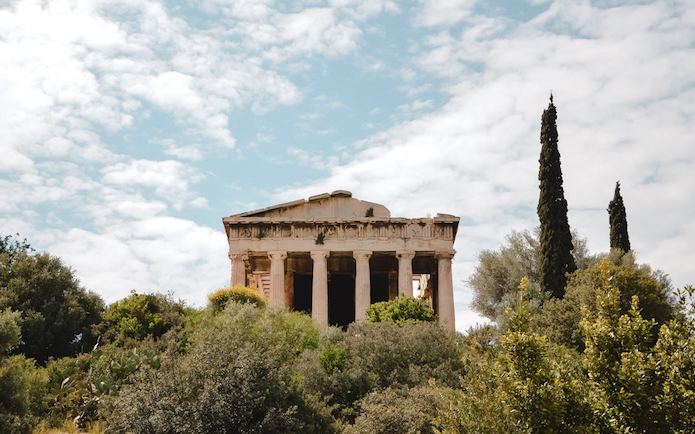
The Ancient Agora used to be the political, commercial and religious center of Athens during Antiquity. All social activities of Athenian citizens were taking place there. You will be able to visit the Stoa of Attalos where Athenians used to walk, talk business but also shop. Today, the Stoa hosts a museum on its ground floor and a beautiful collection of statues on the upper floor.
The other must-see monument is the Temple of Hephaestus, built to honor the blacksmiths’ god Hephaistos. It is one of the best-preserved temples of the agora, mostly because it was transformed into a Christian church. Finally, check out the Byzantine Church of the Holy Apostles. It was built much later than other monuments of the agora and actually dates back to the 11th century, being one of the first churches of its style.
The site is full of trees and shadow while being very quiet, it is perfect for a walk! And it is usually not so crowded, especially in the late afternoon… It must be one of my favorite historical sites in Athens!
Access, opening hours & tickets
The entrance of the Ancient Agora is located on Adrianou street, next to the metro station Monastiraki. Full-priced tickets cost 8€, reduced ones 4€. The site is included in the 30€ combined ticket. Tickets are available on-site as well as online. During the summer months, the site is open between 8:00 and 20:00 and between 8:00 and 17:00 during the winter months.
The Roman Agora
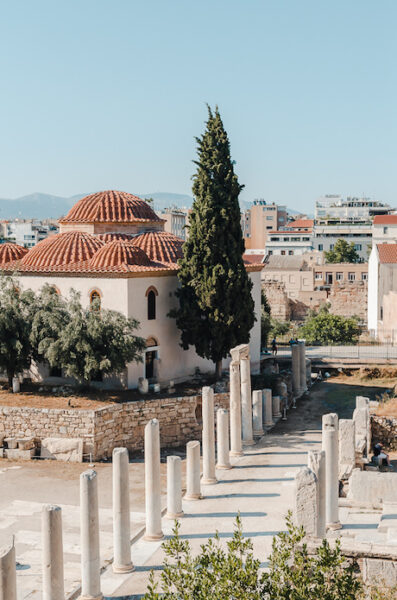
The Roman Agora is located in the heart of the neighborhood of Plaka and its charming colored houses. The site was built much later on after Athens became a Roman province. Its purpose was to replace the Ancient Agora and serve as the new administration and commercial center of the city.
You can admire the monumental gate of Athena Archegetis, the beautiful white marble columns (or what’s left of them!), and at the end of the site the Tower of the Winds. The tower is believed to be the world’s first meteorological station! You can observe on its frieze the eight wind deities, Boreas (North), Kaikias (North-East), Eurus (East), Apeliotes (South-East), Notus (South), Lips (South-West), Zephyrus (West) and Skiron (North-West).
Access, opening hours & tickets
The entrance of the Roman Agora is on Dioskouron street, at the end of Pikilis street. The closest metro station is Monastiraki. Full-priced tickets cost 8€, reduced ones 4€ and the entrance is included in the 30€ combined ticket. Tickets are available on-site and online!
During the summer months, the site is open between 8:00 and 20:00 and between 8:00 and 17:00 during the winter months. However, you can get a really good sight of the site even without entering it! I wouldn’t recommend buying an entrance or visiting unless you already have the combined ticket.
Hadrian’s Library
Located right outside of Monastiraki metro station on Monastiraki square, Hadrian’s library used to be a very big library and cultural center in the Roman Agora. It was named after its main donator, the Roman emperor Hadrian. Today there is not much left except some of the marble columns and walls.
Access, opening hours & tickets
Hadrian’s library is open between 8:00 and 20:00 and between 8:00 and 17:00 during the winter months. Full-priced tickets cost 6€, reduced ones 3€ and the entrance is included in the 30€ combined ticket. Tickets are available on-site or online. Once again, you can basically view the whole site without entering it so I wouldn’t recommend buying a ticket.
Kerameikos
Kerameikos is an area named after potters (kerameis) which had settled their workshops by the banks of the river Eridanos. The river still exists today though its size has shrunk a lot since Antiquity! The site is divided into two areas. One side used to be the potters’ neighborhood, which was located at the entrance of Athens’ gates. On the other side of the Athens’ wall was a cemetery, today believed to be the biggest cemetery of Greece at that time.
Most of what you will see there are ruins, so I would highly recommend you follow a guide if you would like to learn more about the history of the place. The small museum next to the site is worth the visit, you will find there lots of beautiful potteries!
Access, opening hours & tickets
The archaeological site of Kerameikos is located a little further than most sites, which must be the reason why it is always so quiet! The entrance is on Ermou Street, in between the metro stations of Monastiraki and Kerameikos. The walk to the site is really enjoyable! The site is about 15 to 20 minutes away from Monastiraki metro station, but the lower part of Ermou is a quiet, pedestrian street.
Kerameikos is open between 8:00 and 20:00 and between 8:00 and 17:00 during the winter months. Full-priced tickets cost 8€, reduced ones 4€ and the entrance is included in the 30€ combined ticket. Tickets are available on-site as well as online.
The Temple of Olympian Zeus (Olympieion) & the Arch of Hadrian
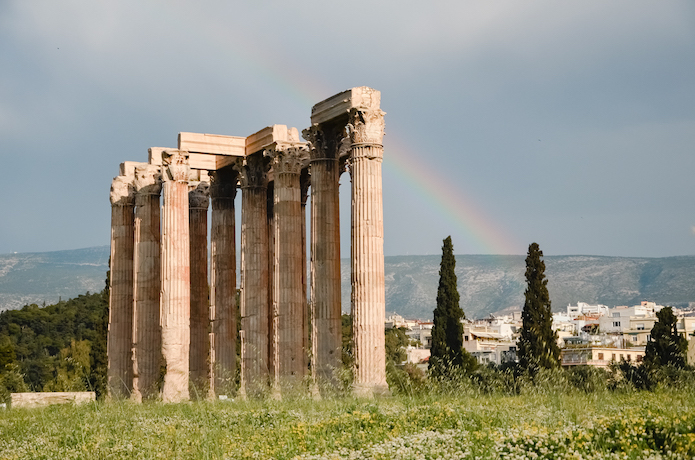
Located at the feet of the Acropolis hill, next to the National Gardens, the Olympieion used to be the sanctuary and the place of worship of Olympian Zeus. This impressive temple hosted many statues, including once the chryselephantine (made of ivory and gold) statue of Zeus. The temple used to count 104 columns in total, of which only 15 are still standing today! The Arch of Hadrian is located right outside the site and was the gate that led from the old city of Athens to the new roman districts built by Hadrian.
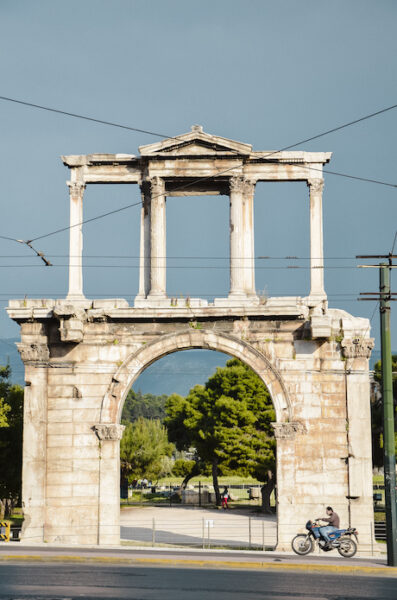
Access, opening hours & tickets
The Temple of Olympian Zeus is located next to Acropolis metro station and is also not far away from Syntagma metro station (5-10 minutes walk). You will find the entrance on Vasilissis Olgas Avenue. The site is open between 8:00 and 20:00 in summer and between 8:00 and 17:00 during winter months. Full-priced tickets cost 8€, reduced ones 4€ and the entrance is included in the 30€ combined ticket. Tickets are available on-site as well as online.
The Panathenaic Stadium
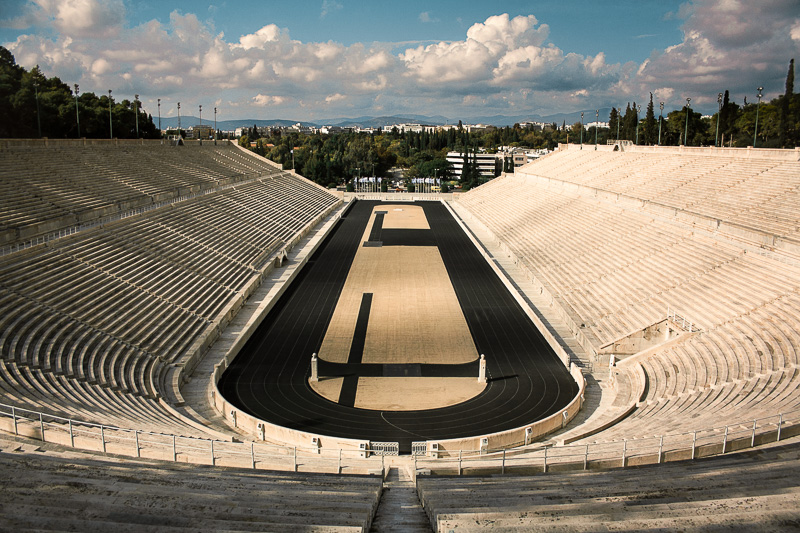
The Panathenaic Stadium is the stadium where the first games nowadays known as the Olympic Games ever happened! During Antiquity, male athletes used to compete against each other there in different disciplines, and this, completely naked. Must have been quite the show!
The stadium’s, entirely made of Pentelic marble, could accommodate more than 50 000 visitors to watch the athletes performing. In 1896, the Panathenaic Stadium welcomed the first modern Olympic Games, and more recently, it welcomes various events like concerts.
Access, opening hours & tickets
You will find the Panathenaic Stadium on Vasileos Konstantinou Avenue, next to the metro stations of Acropolis/Syntagma/Evangelismos. The closest might be Acropolis, but they are all at a walkable distance. Depends where you are coming from! Opening hours are 8:00 – 19:00 from March till October, and 8:00 – 17:00 from November to February. Full-priced tickets cost 5€, reduced ones 2,50€. This site is not included in the combined ticket. More information on the Panathenaic Stadium’s website.
Free admission days in Athens’ historical monuments
There are a few days during the year when you can enter Athens historical monuments for free:
- 6 March (in memory of Melina Mercouri)
- 18 April (International Monuments Day)
- 18 May (International Museums Day)
- The last weekend of September annually (European Heritage Days)
- 28 October
- Every first Sunday from November 1st to March 31st
During these days, you can also benefit from free admissions to most museums in Athens! And remember that there is free admission to most historical monuments (including the Acropolis) and museums for students, EU members under 25 years old, and other cases. You can find more information on the subject on the Ministry of Culture’s website. Finally, you can buy your tickets online or directly at historical sites.
Here was all the information you need to know about historical monuments in Athens! I hope I covered most of the questions that come up when organizing a visit to the ancient sites. If you still are missing something, or need customised advice, please feel free to send me an email at hello@thebeachmuse.com or get in touch with me on social media @thebeachmuse! I’d be happy to help 😊
If you liked this post, leave a comment below, I always love to hear your feedback! And save it for later on Pinterest:
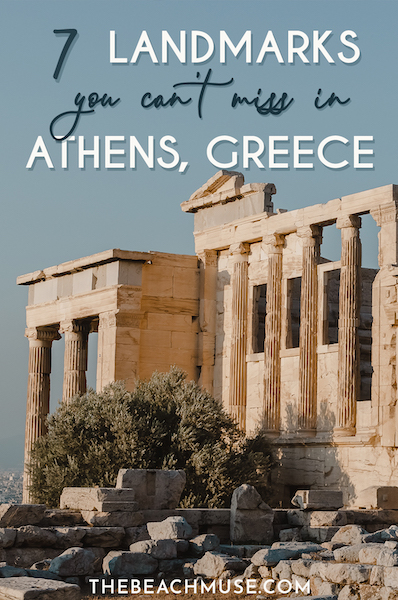
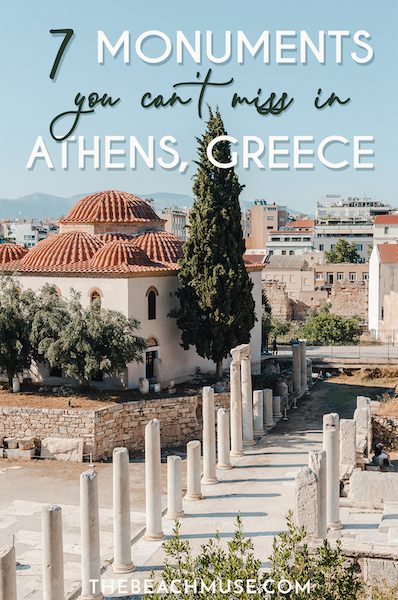
Best tours and experiences to discover the historical monuments of Athens:



